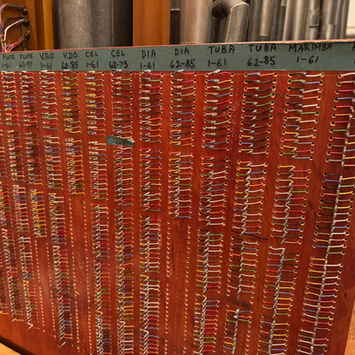the Wurlitzer organ
The Civic Theatre’s Wurlitzer:
A Grand Arrival in New Zealand’s Golden Age of Cinema
The last - and largest - theatre organ to arrive in New Zealand was destined for the grand 3,500-seat Civic Theatre, a stunning example of Eberson-style atmospheric architecture located in the heart of downtown Auckland. Opened in 1929, the Civic was celebrated as the “Showcase of the Pacific,” featuring opulent décor with a foyer styled after “Ancient India” and an auditorium evoking “Ancient Persia.”
At the heart of the theatre’s musical offerings was Wurlitzer Opus 2075—a 3-manual, 16-rank Style 260 “Special.” This powerful instrument, famously said to rise “with a roar that made the marrow dance in one’s bones,” was installed in chambers beneath the stage. Additional instruments, including the piano, chimes, xylophone, and marimba harp, were housed in opera-style boxes on either side of the auditorium, in full view of the audience.
The console itself was mounted on a unique “worm-drive” turntable lift—one of the tallest of its kind in the world. Hidden at the bottom of a deep well, the lift had to ascend 20 feet before becoming visible to the audience. It continued to rise another 17 feet, finally revealing the organist to patrons seated in the Grand Mezzanine, for a total elevation of 37 feet.

The last - and largest - theatre organ to arrive in New Zealand was destined for the grand 3,500-seat Civic Theatre, a stunning example of Eberson-style atmospheric architecture located in the heart of downtown Auckland. Opened in 1929, the Civic was celebrated as the “Showcase of the Pacific,” featuring opulent décor with a foyer styled after “Ancient India” and an auditorium evoking “Ancient Persia.”
At the heart of the theatre’s musical offerings was Wurlitzer Opus 2075—a 3-manual, 16-rank Style 260 “Special.” This powerful instrument, famously said to rise “with a roar that made the marrow dance in one’s bones,” was installed in chambers beneath the stage. Additional instruments, including the piano, chimes, xylophone, and marimba harp, were housed in opera-style boxes on either side of the auditorium, in full view of the audience.

The console itself was mounted on a unique “worm-drive” turntable lift—one of the tallest of its kind in the world. Hidden at the bottom of a deep well, the lift had to ascend 20 feet before becoming visible to the audience. It continued to rise another 17 feet, finally revealing the organist to patrons seated in the Grand Mezzanine, for a total elevation of 37 feet.
A New Beginning:
Farewell at the Civic to a Lasting Legacy at Southward Museum
Regrettably, only one professional recording was made on this magnificent instrument during its time at the Civic Theatre—a 78-rpm album recorded in 1951 by then-resident organist Denis Palmistra. By the late 1960s, the Civic’s owners planned to convert the lower-level Wintergarden Ballroom into a small cinema. The Wurlitzer was seen as an obstacle to this redevelopment. In a poignant farewell concert in March 1968, house organist Ron Boyce played the console into the pit with the Māori love song "Pokarekare Ana." Shortly after, the organ was put up for sale.
Although initially sold to Australian buyers, complications with the removal deadline caused the deal to fall through. The organ was eventually purchased by Sir Len Southward, a Wellington-based entrepreneur and avid collector of vintage automobiles. Due to the theatre’s schedule, the Wurlitzer had to be removed by the end of February 1969.
Right on time, the instrument was dismantled and transported to Sir Len’s factory in Lower Hutt, near Wellington. Over the next ten years, it underwent extensive restoration before being installed in a purpose-built theatre next to the main showroom of the Southward Museum Trust.
The museum, known for its remarkable collection of vintage cars, steam engines, and mechanical curiosities, became the Wurlitzer’s new home. It officially reopened in 1983, with organ chambers flanking the auditorium and the console once again mounted on a turntable lift—though this time not quite as dramatic in height as at the Civic Theatre.








